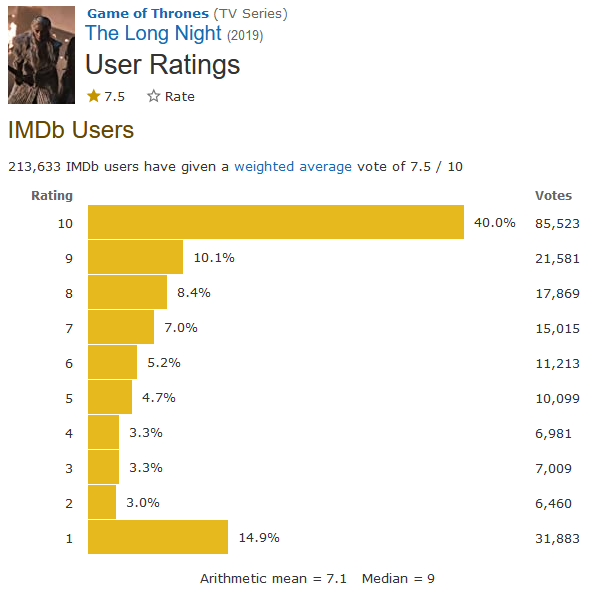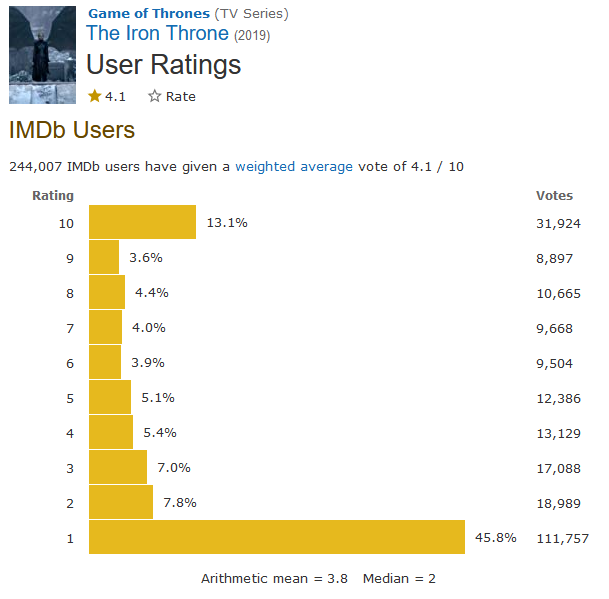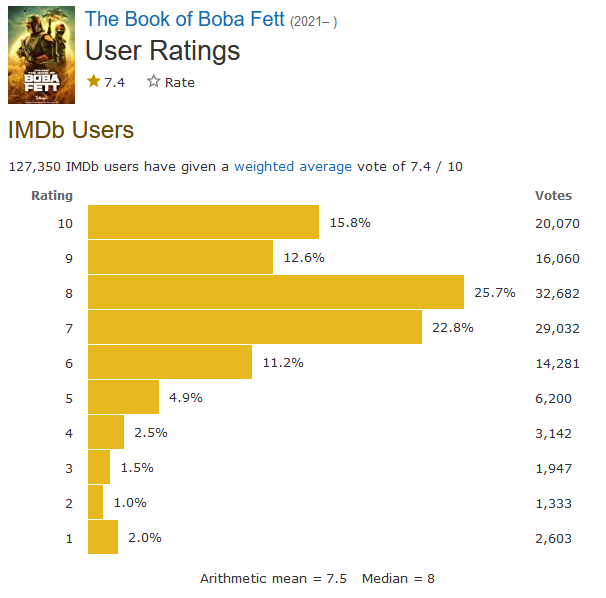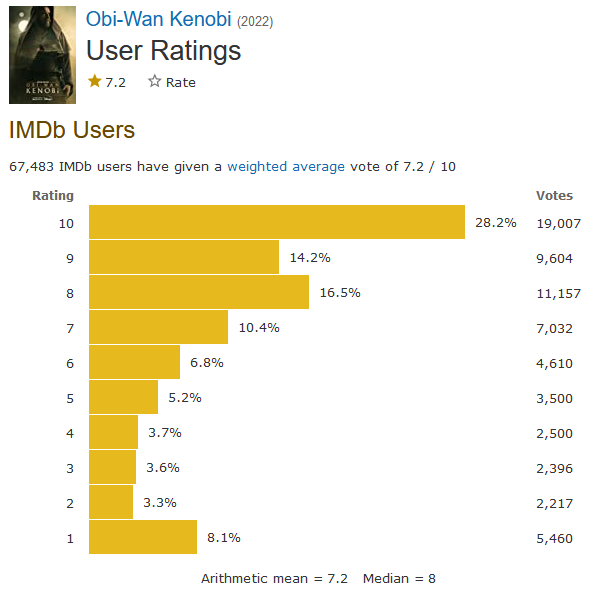The Film Review Scale
The problem
It would seem many people cannot rate and review shows/films properly. Evidence of this can be found strewn across IMDb, Rotten Tomatoes, and Reddit. There are franchise cults for things like Star Wars, where every show and movie are seen as brilliant despite glaringly obvious flaws. There are those who review things too critically, with low scores being dropped when they find things boring or outrageous. Then there are people who claim everything is 10/10, meaning exceptional all around.
If we look at Game of Thrones, 40% of IMDb reviews for episode 3 of season 8 were 10/10. 40%! Are you having a laugh? The Long Night must be near perfect.

Moving on to episode 6, the finale, 13.1% gave it 10/10, 29% in total gave it 6+/10, and 45.8% gave it 1/10. The ratings flipped, but about a quarter of people still considered it above average.

As another example, 15.8% of reviews were 10/10 for the entirety of The Book of Boba Fett, with 12.6% being 9/10 and 25.7% being 8/10. ~55% of ratings are 8+ on IMDb.

Finally, 28.2% of Obi-Wan Kenobi reviews were 10/10, with 14.2% giving it a 9 and 16.5% giving it an 8. Nearly 60% of ratings are 8+.

Newsflash: season 8 of Game of Thrones was an objective writing catastrophe, and these recent Star Wars shows are not good, let alone excellent.
Reviewing a show/movie is more than about enjoyment or feeling. Yes, they’re entertainment, and that’s important, but enjoyment alone is a poor gauge of quality and misses the multidimensional nature of film.
Alongside this overreliance on enjoyment, I think these inaccurate reviews stem from four other main factors:
- Bias
- An inability to notice what’s going on
- An inability to think critically and objectively
- The 1-10 rating scale being tricky to grasp
Bias is never going away, some people won’t care enough about what they’re watching, and idiocy is here to stay too, especially whilst social media is so popular. However, perhaps something can be done about this 1-10 scale, and maybe that will help with the other factors to some extent. That’s where my Film Review Scale comes in.
The (partial) solution?
No matter what people say, there’s some objectivity in film reviewing. Unrealistic writing, stereotypical characters, a lack of depth, wooden acting, poor casting, an excessive runtime, unnecessary scenes, shaky cam, rapid cuts, fake or over the top action, dodgy CGI, movie looking sets, and a repetitive soundtrack are examples.
This fact and the existence of categories that should be evaluated when rating a film mean we can break down this overarching 1-10 scale and calculate a rating based on each component, with some categories being more important than others.
My Film Review Scale consists of 10 items/categories:
- Plot
- Characters and dialogue
- Acting and casting
- Pacing
- Cinematography
- Editing
- Practical and visual effects
- Production design (sets/props/costumes)
- Sound effects and soundtrack
- Enjoyment/feeling
Items 1 and 2 are given double the weighting because writing often makes or breaks a film, whereas people can live with some bland cinematography or dated visual effects.
Each item is rated using a 5-point Likert scale, with lower being worse:
- Terrible/well below average
- Bad/below average
- Ok/average
- Good/above average
- Excellent/well above average
A 5-point scale was chosen because any less would be too vague and any more could make classification overly complicated. The goal is for the scale to have utility whilst being sufficiently easy to use.
Once you add up the 1-5 rating for each item/category, you get a total score out of 60. This score can then be divided by 60, multiplied by 100, and rounded to the nearest 1-10 rating.
The scores for each category can help indicate inaccuracy, things to pay attention to upon a rewatch, and weaknesses/strengths. However, I recommend keeping some notes to clarify the good and bad.
The limitations
‘If you give a calculator to a f** r*****, he’s gonna try to turn on a TV with it’. It’s time to up your film watching game if you didn’t get this reference.
This type of mathematical scoring is not always going to align with your actual rating. That may be a good thing, or it might mean inflated scores because, for example, only the writing is bad.
Some categories were merged to reduce complexity, but how do you score a film with excellent practical effects but terrible CGI? Not that this example is a major problem for modern films given their overreliance on CG.
Editing and production design are particularly tricky to rate. Few people notice editing unless it’s blatantly terrible like for the fight scenes in Jason Bourne. Cinematography, production design, and the soundtrack are often average or unnoticeable again.
What is average? Is it average for that genre or across genres? Where do you draw the line between ‘good’ and ‘excellent’/’bad’ and ‘terrible’?
The quality of each category could vary throughout the show/film. For instance, there’s some excellent CGI in Dune (2021), but there’s also a sequence from the trailer showing loads of fighting that looks completely animated and off.
Tackling the limitations
The scale requires honesty to work properly. Hopefully the categories cue recollection and evaluation, perhaps even encouraging someone to revisit scenes, the soundtrack, or the entire film.
Sometimes making small adjustments can tip a score over. Failing that, your hypothetical score could be misleading, the scale needs a revision, or it’s not possible for this type of scale to have such accuracy.
The categories could be separated if necessary, but it’s more likely that you have to take an average of both or assess one over the other (e.g. acting rather than casting).
It should become easier to evaluate things like cinematography and editing with greater experience and attention. A lot of the time, however, these things are rather ordinary and thus don’t deserve much of a mention. An example of standout cinematography for me would be Mr Robot.
Production design really comes down to realism and believability. Sets are frequently spotless, and costumes representing metal may look like plastic. Judging the soundtrack is about its appropriateness, emotional impact, and originality/memorability.
To me, average should be across genres, although a film’s budget could arguably be taken into account. ‘Terrible’ is nearly or completely unwatchable. ‘Bad’ can be watchable, but you know there’s a lot wrong. ‘Ok’ is watchable but nothing special. ‘Good’ loses the mediocrity of ‘ok’, meaning greater quality and entertainment. Lastly, ‘excellent’ is rare and really sparks feeling/interest, going beyond merely enjoyable.
Finally, the quality per category should again be an average. If a film has some noticeably poor CGI, it shouldn’t get the highest rating. However, if it’s infrequent, then it shouldn’t get a low rating either. This is common sense, something lacking from reviewers at the extremes.
To infinity and beyond
The state of platforms like Netflix and franchises like Star Wars is in shambles. As consumers, we should want better quality products, not endless garbage. Speaking your mind is part of that, and money talks. Review what you watch, unsubscribe from Netflix, and let me know your thoughts on the scale.